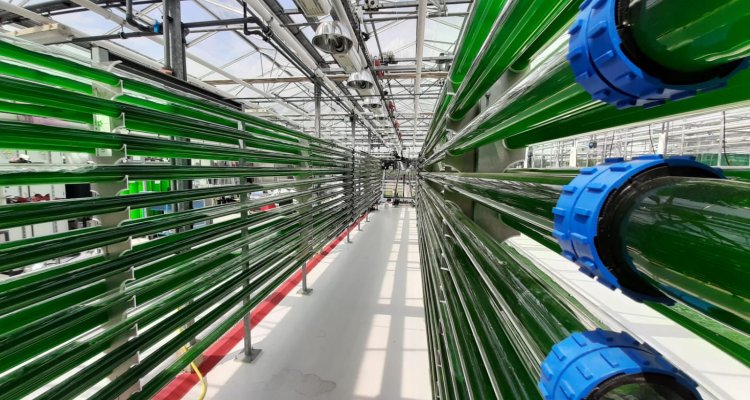
Project
Scaling up mixotrophic cultivation of extremophilic microalgae
Oxygen-balanced mixotrophy has the potential to circumvent the limitations of current cultivation systems by improving cell densities, productivities and substrate yields while removing gassing requirements. In this project we aim to scale up this process from the lab to pilot.
Background
Microalgae are a promising feedstock for the development of the biobased economy. However, their currently low productivities and high costs have limited their application to a few high-value products. Mixotrophic cultivation offers the possibility to improve conventional cultivation systems by simultaneously growing the cells with light and an organic carbon substrate. In this way, autotrophic and heterotrophic metabolisms are combined, improving autotrophic cell concentration and productivity while maintaining photosynthetic carbon fixation.
Mixotrophy can be further improved by fine tuning the amount of organic carbon substrate that is provided to the cells. Then, photosynthetic oxygen production can be balanced with heterotrophic oxygen consumption. The same principle applies to carbon dioxide: the required amount for photosynthesis can be provided by the oxidation of the organic substrate. Such gas recycling has a direct impact in the overall energy demand and process costs by removing or minimizing external gassing requirements in the reactors. Moreover, due to intracellular carbon dioxide recirculation, 90% of the carbon in the substrate ends up in the biomass.
So far, oxygen-balanced mixotrophy has shown promising results in lab scale. The next step involves bringing this process to larger volumes with all the corresponding challenges: non-ideal mixing at large scale, natural day/night cycles, temperature fluctuations and pH control or managing contamination.
Project description
This project aims to scale up oxygen-balanced mixotrophy in tubular photobioreactors. First the project will focus on understanding large scale conditions in a laboratory setting. The information gathered will then be used to design and test efficient mixotrophic cultivation at pilot scale. The experimental outcome will be used to assess the bottlenecks and feasibility for industrial application of this novel cultivation process.
Simulation of large scale conditions will be performed in lab-scale photobioreactors, where cultivation conditions such as light, substrate supply, temperature and pH can be tightly controlled. On the other hand, pilot-scale cultivation will be performed in tubular reactors available at AlgaePARC. Relevant physiological and process parameters will be monitored during the cultivations and the obtained data will be used for qualitative and quantitative analysis to determine the growth rate of the microalgae and to optimize the control of the process. For example, by means of mass balancing in combination with growth and reactor kinetic models.
As model species for the scale-up of oxygen-balanced mixotrophy, we use the acidophilic microalga Galdieria sulphuraria. The polyextremophilic nature of this species simplifies dealing with contamination at large scale, which becomes a significant challenge in the presence of organic substrates. Moreover, this species is source of interesting compounds for industrial application.